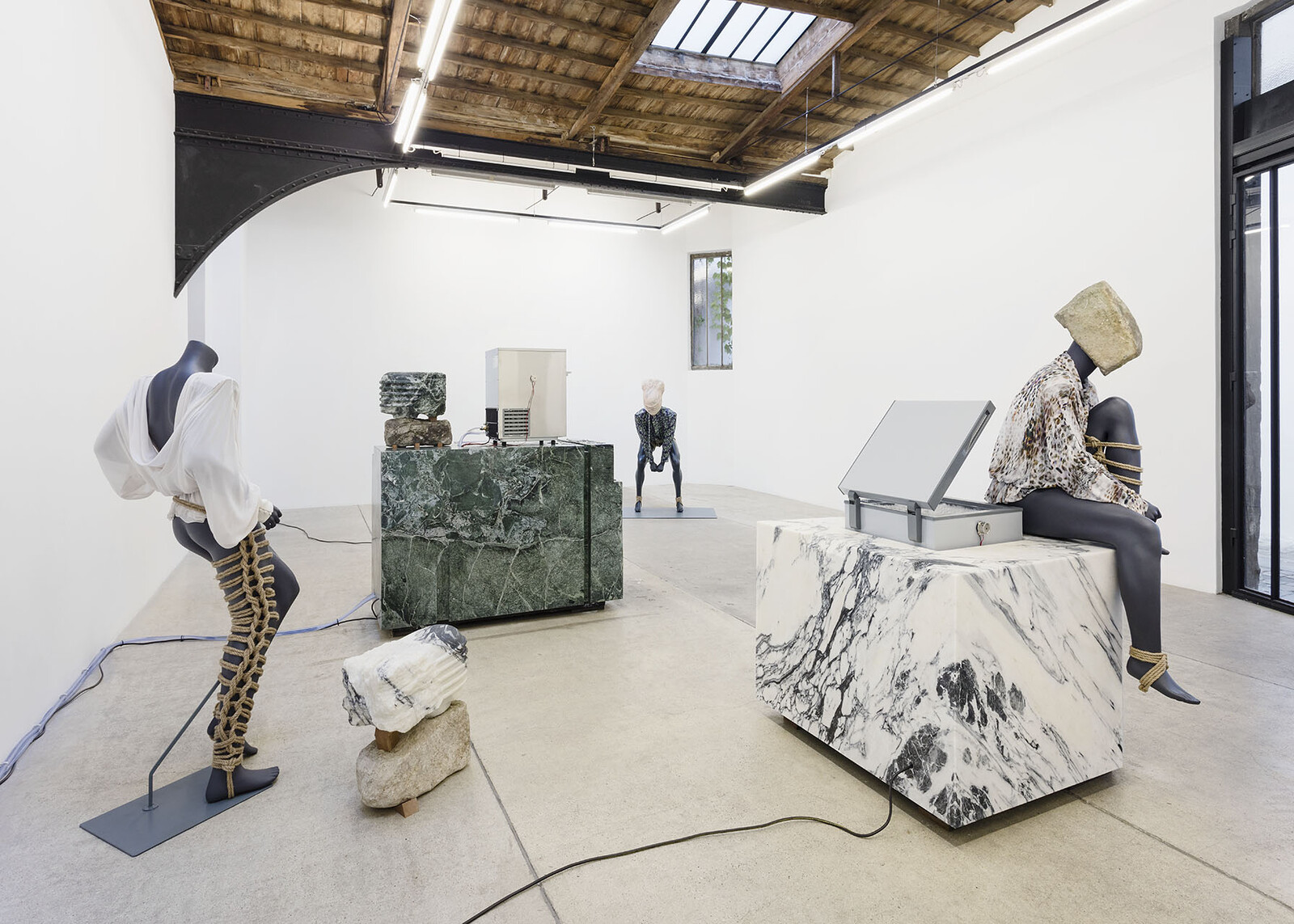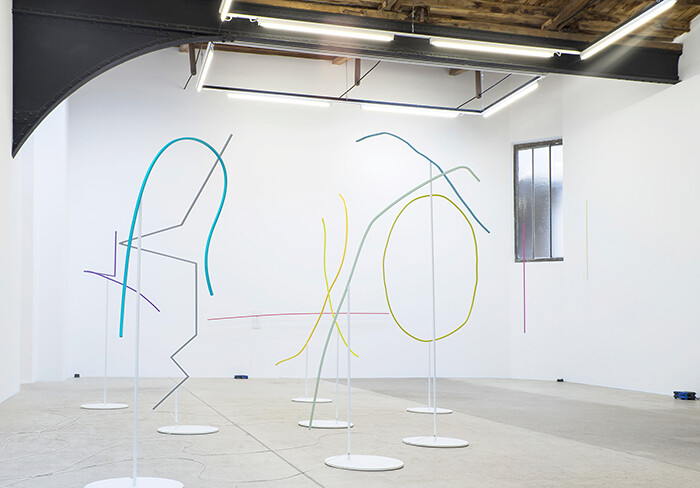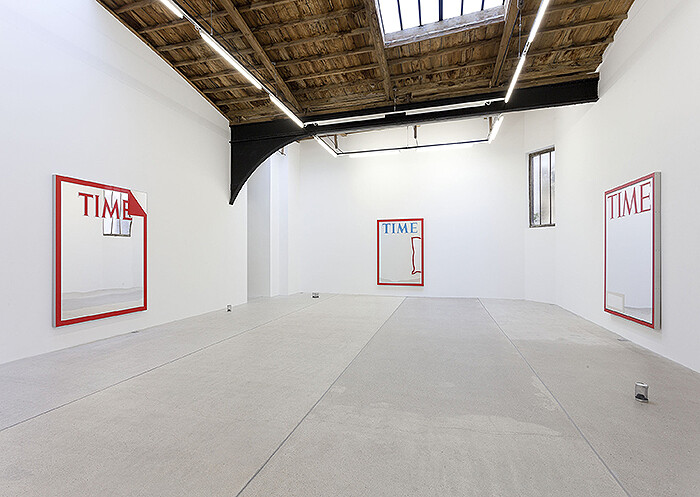Categories
Subjects
Authors
Artists
Venues
Locations
Calendar
Filter
Done
December 15, 2022 – Review
Mungo Thomson’s “Sideways Thought”
Francesco Tenaglia

Mungo Thomson is a California-born conceptual artist in the lineage of John Baldessari and Ed Ruscha. His works often appear in serial forms that change over the years, adapting to different display contexts and making a virtue of repetition itself—framing, editing, and magnifying found objects and images from popular visual culture.
At the center of his solo presentation at frank elbaz gallery in Paris is a strong example of this tendency. Projected in the gallery’s darkened first room is Volume 5. Sideways Thought (2020–22). Part of the artist’s “Time Life” series of stop-motion animations that draw on encyclopedias and other sources of found imagery, the video consists of a montage of every photograph of Auguste Rodin’s sculptures available in books about the artist’s work. The idea is to mimic, or allude to, the operations of a high-speed scanner while transforming paper archives into digital databases for universities or research centers. Yet the breakneck speed of the editing also illustrates an artistic possibility: that an artwork can be generated from the processes of digital sublimation. Thomson’s use of ancillary documentary materials, and indexical and archival practices (those building blocks of art history), extend into Rodin’s desire to capture the naturally continuous …
November 12, 2020 – Review
Bojan Šarčević’s “L’Extime”
Tomas Weber

Bojan Šarčević’s aloof, unyielding mixed-media sculptures skirt the boundary between glacial reserve and slushy poignancy. In his first exhibition at Paris’s Frank Elbaz, he delivers frostiness and emotion in a single blow.
Three works in the first room, all titled Homo Sentimentalis (all works 2020), involve immense, magnificently polished marble blocks, ranging from ivory white to deep grey, that are carved with ridges, indentations, and geometrical notches. Muscular plastic mannequins wearing eighties-style silk blouses and naked from the waist down pose on and around the marble blocks. One figure, seated on black-veined white marble, has a lump of raw limestone for a head. The head of another figure, half-crouching as if about to pounce, is of marble carved with curved ridges; it holds two dagger-like objects, also marble, in its fists. A third mannequin—this one is headless—looms mid-movement, perhaps running or dancing, at the back of the room. The legs and feet of these vaguely alarming, hybrid forms are all neatly bound with jute bondage rope.
Two of the marble blocks have been hollowed out to contain readymade ice chests, the lids of which are open. Switched on and fully operational, they release cold air into the space; empty …
March 24, 2015 – Review
Davide Balula’s “A journey through you and the leaves”
Mara Hoberman

Featuring bright colors and interactive technology, Davide Balula’s current exhibition seems, at first glance, a significant departure from the artist’s earthy process-oriented oeuvre. It’s certainly in stark visual contrast to his last show with Frank Elbaz, “The Buried Works” in 2012, which turned the gallery into a vivarium with six blank canvases submerged under several tons of dirt where they were acted upon by natural corrosive and fungal processes. Here, “A journey through you and the leaves…” centers tidily around a series of internet-connected sculptures. Though less sensorial than his previous loamy environment, Balula’s current installation is, conceptually speaking, likewise fecund.
“Coloring the WiFi Network” (2015), comprises 17 thin plastic and metal sculptures, each a unique steel squiggle painted a different color. A cluster of these vibrant minimalist works—arrayed around the center of the gallery—are mounted on barely-there white stands so that the whole lot appear to hover in space, just like a Dr. Seuss-ian skyline of wacky rooftop antennas. Elsewhere, tucked into corners, rounding doorways, and mounted on the wall, isolated antennae recall the once ubiquitous (oft jerry-rigged) TV set-top rabbit ears. Despite initially evoking analog transmitters, these works are of and about our digital age. Their linear forms refer …
September 18, 2013 – Review
Mungo Thomson
Kevin McGarry

In his first exhibition at Galerie frank elbaz, Los Angeles-based artist Mungo Thomson balances tidy conceptualism with dexterous formal conceits in his ongoing, obsessive abstractions of the editorial purview and design of the iconic TIME magazine. Minimally installed, the exhibition is anchored by a room of four wall-mounted mirror works scaled roughly to the size of a tall man, like the artist himself. Styled after the immediately recognizable graphic design of the magazine, each mirror pane is framed by a red line within which the four letters of TIME are printed in a concise array of differing colors and serif fonts.
The typography, which slightly varies from one mirror to the next, directly corresponds to the design used for the magazine issues whose original photographic cover image Thomson has effectively erased in favor of the viewer’s own reflection—March 23, 1987 (The Nature of the Universe), April 16, 1990 (Unlocking the Secrets of the Universe), August 4, 2003 (The Science of Meditation), and October 13, 1975 (Meditation: The Answer to all Your Problems?) (all works 2013). Each of the editions that Thomson selected for the exhibition alludes to metaphysical concepts, the inner mind, or outer space—enduring themes that shape the larger constellation …